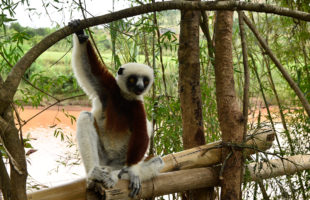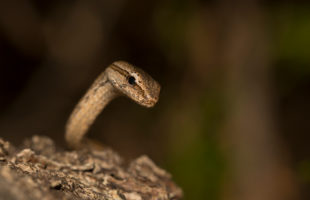Madagascar’s coasts are home to a secret that few travellers know about. Not only is the island itself a treasure trove of biodiversity, but the sea around it is home to particularly rare mammals: dugongs (Dugong dugon).
They depend on seaweed for their entire lives
In Madagascar, they are called lamboara or trozogno. The term “sea cows” goes back to their diet. Because their entire life, which can last up to 70 years, revolves around seagrass. It is the only thing dugongs eat all their lives. And they are also choosy: not all seagrass is acceptable. Most dugongs prefer easily digestible, highly nutritious seagrass with very low fibre content. Only if there is really nothing else available will dugongs sometimes be satisfied with algae. For hours, even days, they graze slowly above the ground in shallow, coastal sea areas with particularly tasty seagrass meadows. The tactile hairs on their mouths reliably always find the best grass.
In the dugong grounds around Madagascar, eight different species of seagrass are currently known to preferentially consume the only herbivorous mammals in the sea. These include Pacific turtle grass, various ribbon grasses, needle and noodle seagrasses, spoon grass, and dwarf seagrass. Each dugong grazes an area of about 4000 m². In the process, it slowly wanders over the seabed with its front flippers, stirring up sediment and at the same time fertilising the grazing grounds with its leftovers.
Dugongs are distantly related to elephants
To enable them to graze comfortably suspended on the seabed, dugongs have developed fascinating features. Their ribs and long tubular bones are among the densest in the world, making them exceptionally heavy. Around 420 kg is the average dugong at three metres in body length. This extra weight probably helps the animals to stay better on the seabed.
Dugongs usually live alone or in pairs, and it is rare to see more than two animals together. This probably has to do with the fact that most seagrass meadows could not support larger groups of dugongs. So each animal or pair looks for its own pastures. Yet dugongs are actually social animals. They communicate with a whole range of different sounds that can be heard far through the water. Although they have no visible ears, their hearing is much better than their sight.
Dugongs are emblematic of the Malagasy mantra mora mora – always take it easy. They usually travel at a leisurely 10 km/h. They can dive for up to six minutes and reach depths of up to 40 metres.
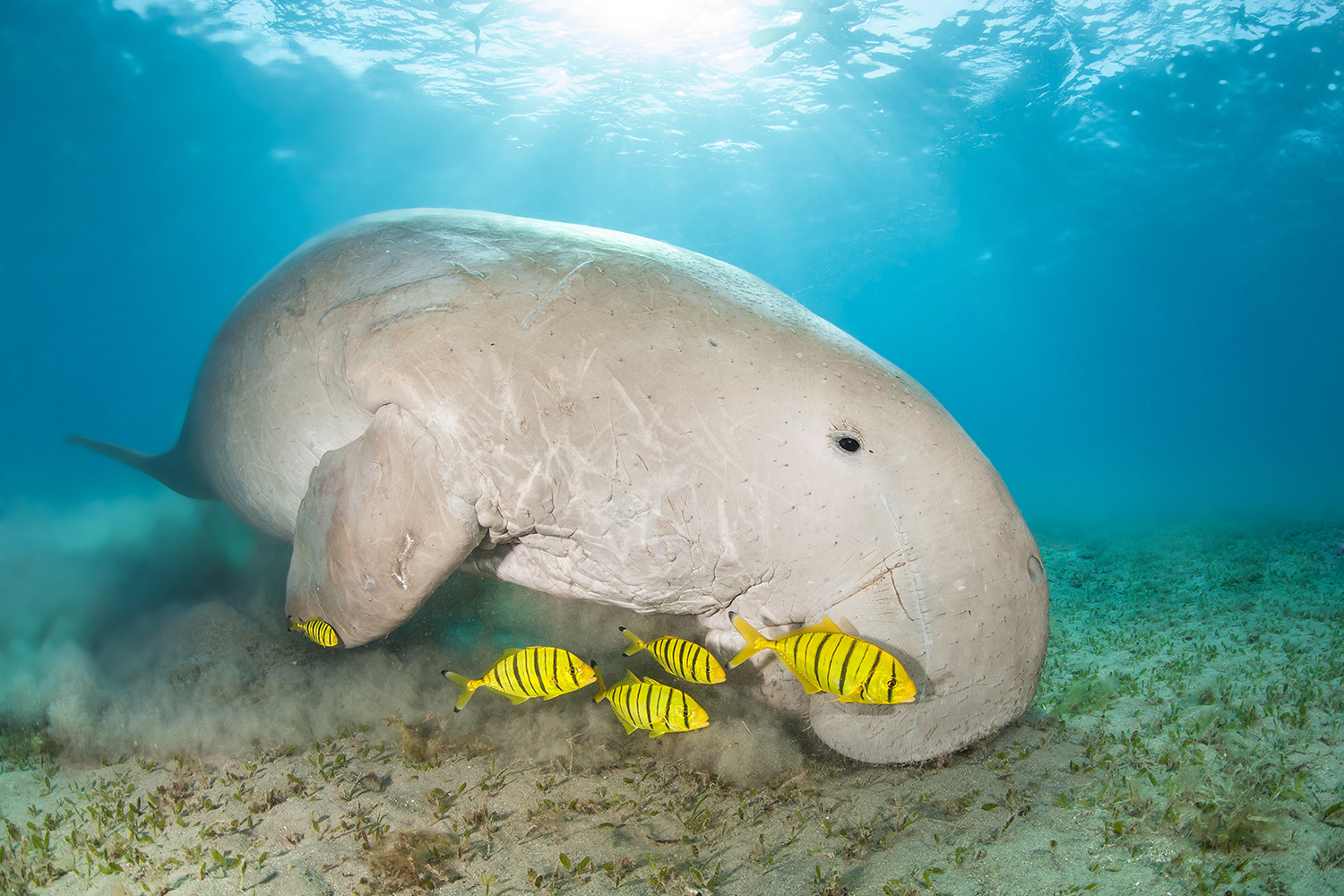
The disappearance of the dugongs
According to old stories, dugongs used to be found all around Madagascar. In the bays of St. Augustin south of Toliara and in the bay of Soalala in the west, there were repeated sightings of the cosy marine mammals. Sightings have also been reported in Antongil Bay, adjacent to Masoala National Park. As late as the 1980s, large groups of dugongs lived on the southwest coast of Madagascar, between Bevato and Andavadoaka. Other coastal areas frequently visited by dugongs at that time were the Ampasindava peninsula, the fishing island of Nosy Faly, and the islands around Nosy Mitsio in north-western Madagascar. There have even been sporadic sightings from the island of Nosy Boraha (St. Marie) on the east coast.
Surveys in recent years, however, revealed shocking developments: since the 1990s, sightings have declined massively. Today, dugong sightings around Madagascar have become extremely rare. They are more like winning the lottery. Even fishermen who go out to sea every day only encounter the animals a few times a year instead of every day as they used to – some never see one for the rest of their lives. Around Nosy Be and the neighbouring smaller islands, no dugongs have been sighted for years, these populations seem to have simply died out.
Dugongs were hunted for a long time
But where have the dugongs gone? The reasons are many, but one thing can be said for sure: humans are the main cause of the disappearance of dugongs around Madagascar. For centuries, dugongs were hunted worldwide for their meat and the oil extracted from their fat. The oil could be used to treat wooden pirogues, and the meat was eaten. According to the Washington Convention on International Trade in Endangered Species of Wild Fauna and Flora (CITES), dugongs, like their meat or other products, must not be traded. Madagascar has been part of CITES since 1975. But so far this has been of little use to the large marine mammals.
Especially in areas in the south and west of Madagascar that are severely affected by drought every year, the gentle sea giants have long been easy prey and coveted food for extremely poor fishermen. The catching and cutting of dugongs are subject to numerous taboos, the so-called fadys, on all coasts of Madagascar. This testifies to how valuable such a catch used to be for people and how rare it has become today. It used to take six fishermen to catch a single dugong – four toiled to catch it, two took care of the boat. In many places, the cutting of the dugong took place according to strict rituals that are still in place today: The head and genitals must be covered with a white cloth, women and children are not allowed to take part in the cutting and pregnant women are not even told about it. In some places, the bones have to be returned directly to the sea. In some coastal places, it is believed that anyone who touches the heart of a dugong with a knife is cursed.
In the past, a special large knife, the mesobe, and a narrower knife, the kanife, were used for cutting. The meat was cut into strips and dried. This way, it could either be kept for personal consumption or sold on the market. In the 1980s, a kilo of dugong meat cost a few ariary (barely one euro/dollar), but today the price is unaffordable for most Malagasy.
When a dugong is cut up, the distant resemblance of the marine mammals to mermaids also comes into play in Madagascar. Fishermen who caught a dugong used to have to swear after the catch that they had not had sex with the animal.
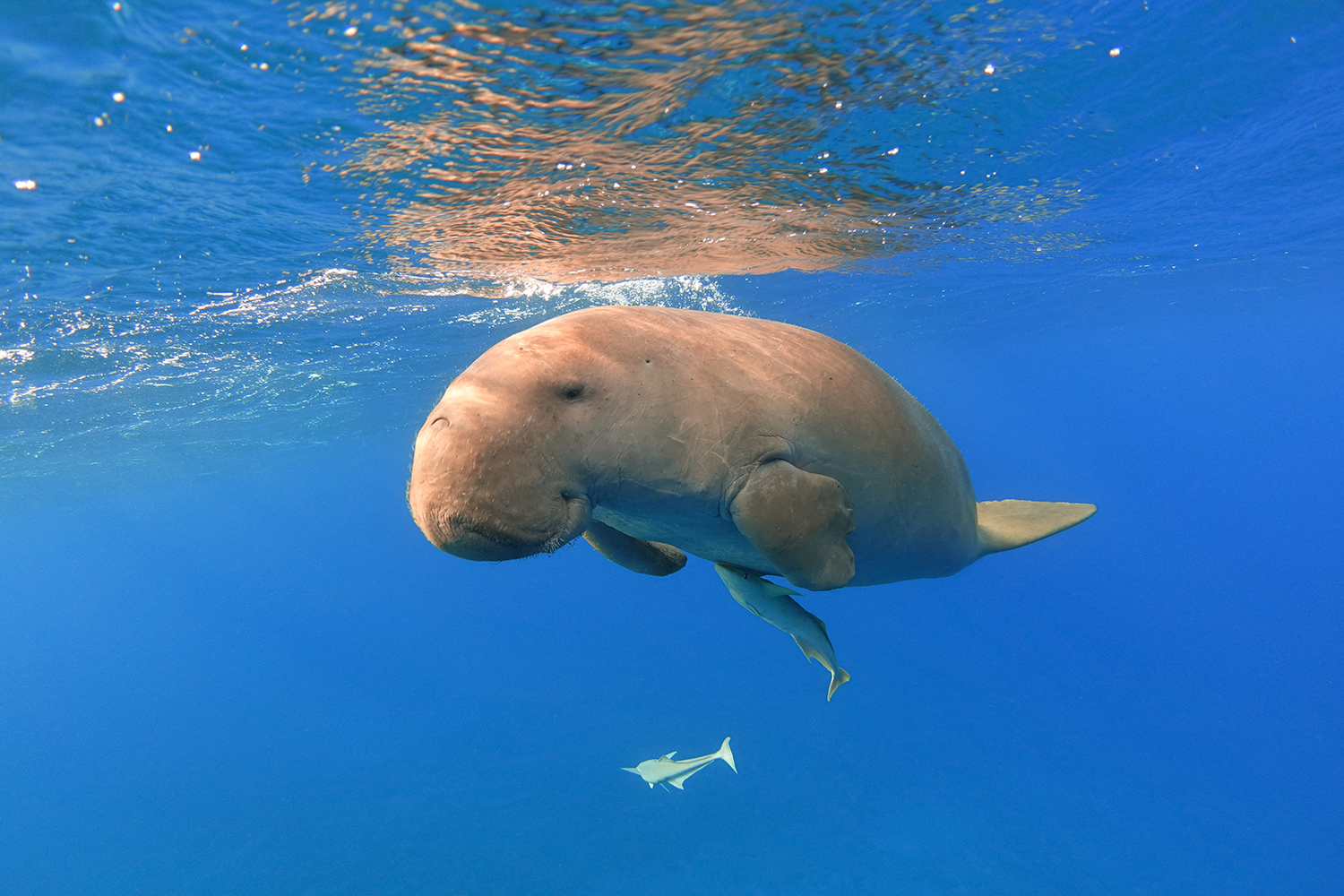
Where they were not specifically hunted, dugongs were always an unwanted by-catch. The gill nets (jarifa or zedazeda) used in Madagascar to this day, fishing nets that stand vertically in the water, repeatedly caused dugongs to get stuck in them and suffocate miserably. Today, such bycatch is a rarity, but still occurs – especially where fishing is done illegally in marine protected areas.
Incidentally, only one ethnic group in Madagascar has a fady that generally prohibits the hunting of dugongs: The Vezo, the semi-nomadic fishing people in the southwest of the red island.
Slow reproduction prevents dugong stocks from recovering
Besides hunting, there are other reasons for the disappearance of dugongs: one is their very slow reproduction. Dugongs are late bloomers. They only become sexually mature between eight and eighteen years – quite late for a mammal. Females give birth to only a few young all in their lives, and only one at a time. Gestation lasts between 13 and 15 months.
To give birth, the female dugong retreats to very low water just offshore. This behaviour ensures her protection from larger predators such as sharks or whales, which do not come so close to shore. The dugong calf is born over a metre long and weighs a good 30 kilograms. The mother immediately pushes it up to the water’s surface so that it can take its first breath. Over the next months and years, the calf always stays in close contact with its mother. It hardly moves more than a few metres away from her and constantly tries to keep in contact with the cow with its fins or mouth.
Each young animal is painstakingly raised and cared for over years. The mother suckles the calf for one and a half years alone. But even after that, it stays with its mother until it is sexually mature. During this time, the mother usually does not mate again. A marine mammal that reproduces only every six to eight years: a very sensitive target for fishing and habitat loss.
The habitat of the dugongs is dwindling
Dugongs are also very sensitive to pollution. They can hardly cope with the increasing plastic in the seas. Individuals regularly die from it. Their habitat is disappearing and their preferred feeding grounds, the coastal seagrass beds, are becoming fewer and fewer. Motorboats, overfishing in nearshore waters, and human activities in particularly picturesque, shallow bays are destroying the valuable seagrasses. About a third of the world’s seagrass stocks have already been eradicated from the oceans – and every year another 110 km² or so of destroyed seagrass pastures are added. Yet seagrass pastures, just like coral reefs and mangroves, are very important for our ecosystem. They are not only habitat and food for fish and dugongs, but also increase the water quality of the sea. In addition, around 10% of the CO2 stored in the sea is due to seagrass pastures – it can store up to ten times more CO2 than the same area of rainforest.
In addition, dugongs are shy animals – they do not like disturbances. If humans regularly come too close to them, they retreat and switch to other feeding grounds. However, they are seminomadic. They can swim long distances but never move outside a certain home range. And even after years, they still try to return to destroyed seagrass areas they remember.
Hunting in combination with the extremely slow reproduction rate and their dwindling habitat means that Madagascar’s dugongs have only a few habitats left in the north and northwest. Initial studies show that the current fragmented and very small populations live mainly on the relatively pristine seagrass pastures between Mahajanga and Sahamalaza in the northwest. Another population seems to occur around Nosy Hara in the north.
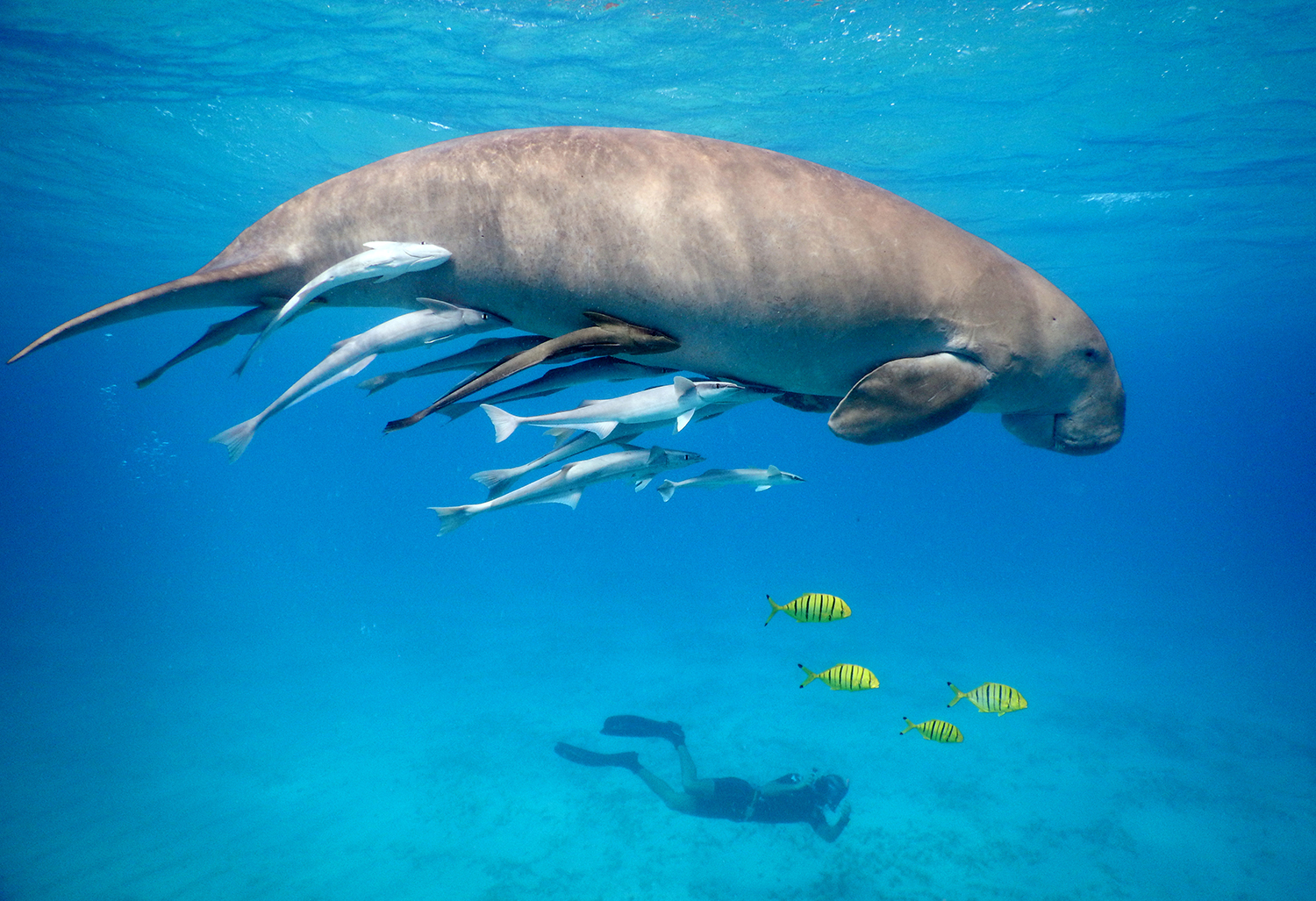
The protection of dugongs in Madagascar is making slow progress
It is only in the last decade that something has been done for the dugongs in Madagascar. Marine protected areas have been established: Sahamalaza and the Radama Islands, Ankarea and Akivonjy on the Ampasindava Peninsula, and the marine protected area around Nosy Hara island. More than 9000 km² of the marine area around Madagascar is now protected.
But the marine protected areas do not establish themselves on their own and, above all, do not simply remain protected. The Dugong and Seagrass Conservation Project, a global NGO based in Abu Dhabi, is one of the organisations working for Madagascar’s dugongs. Together with Blue Ventures, MIHARI, C3 Madagascar, Wildlife Conservation Society, and COSAP, it is currently promoting several projects around the islands of Nosy Barren and along the west coast around Mahajanga, in the Sahamalaza National Park up to the northernmost tip of Madagascar, the Nosy Hara National Park.
Monitoring the protected areas, the dugongs themselves, and the fisheries is only part of the work. The priority is to improve the living conditions of the people who have lived in the protected areas up to now. This includes improved medical care, new livelihood opportunities, education in environmental protection and sustainable fishing as well as food alternatives. Those who earn their living from duck farming or handicrafts are less likely to have to resort to the sea. And those who know how the marine ecosystem and our own lives are interconnected are more committed to protecting coastal seagrass beds.
The first small successes are now emerging: The knowledge that dugongs are an important part of the marine ecosystem is slowly but steadily spreading. Fishermen no longer specifically hunt for dugongs – and let them move on if they happen to spot one or catch one as unwanted by-catch. And the efforts to preserve the remaining seagrass pastures have begun to bear fruit: the first dugongs have returned.
title picture© Маргарита Грановская, licensed at AdobeStock
grazing dugong, swimming dugongs © b.neeser, vkilikov, a_g_owen, licensed at AdobeStocks
 MADAMAGAZINE Your Magazine about Madagascar
MADAMAGAZINE Your Magazine about Madagascar

